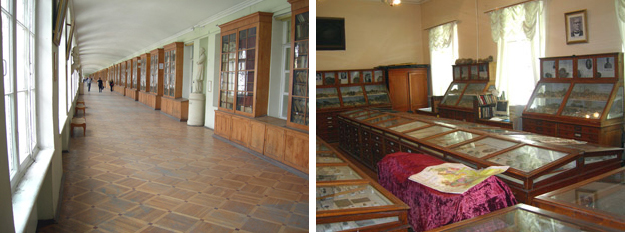I am absolutely stunned by the beauty of this city. The ornate architecture and building colors combined with the water and changing skies, all marinated in more historical drama than any city should bear, is overwhelming. I can’t imagine a more different Russian city from Moscow. I have been privileged to see the sights here as a guest with personal narrative tours. It is quite the place to emerge into after all those field days. Our field house is only four hours by train from the city center, yet it seems thousands of kilometers away now.
My work here with Andrey is to look at his collection of Ordovician limestone and fossil samples at the University of St. Petersburg. That task alone is in an impressive setting. His office is in the Twelve Colleges building, which was designed by the Italian architect Trezzini and completed in 1742. It is an extraordinarily long set of twelve connected buildings, all linked by a Mediterranean-style corridor.

My morning walking commute on the left, and the entrance to the Twelve Colleges building on the right.
The collections are in a classic old European cabinet room dominated by portraits of generations of geologists and filled with glass-topped sets of drawers.
After studying the specimens, Andrey took me on a long walk through the city. Our first stop was the living quarters and laboratory of the university’s most famous professor, Dmitry Mendeleev. We had a personal tour of this amazing man’s place, complete with stories of his life. Not only did he develop the periodic table of the elements, but he was also an engineer, economist … and geologist! He recognized the future value of petroleum and worked on ways for Russia to efficiently use its oil resources. We then continued across three islands making up the most historical part of the city, seeing all that we could. With the white nights extending the afternoon light, that was quite a bit.
On the next day I made my own trip to see a famous ship I’ve long dreamed of boarding: the Cruiser Aurora. This is the ship that signaled the beginning of the Bolshevik Revolution in 1917 by broadcasting a speech by Lenin and then firing a shot from its forward gun which started the storming of the Winter Palace. It is also a veteran of the Russo-Japanese War and served throughout WWI and WWII.






